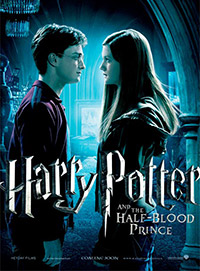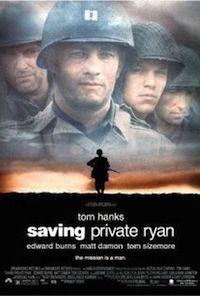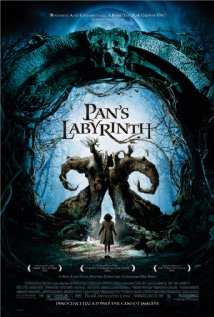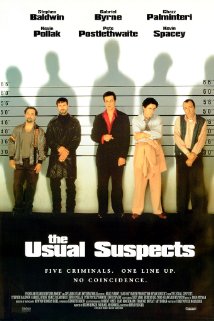A guest post by M. Scott Boone.
 “The book is better.” We’ve all heard it; we’ve all said it.
“The book is better.” We’ve all heard it; we’ve all said it.
But why do we make that judgment? And more importantly, how can we, as writers of said better books, use that reason to improve our writing? Harry and Ginny, Book and Movie
I’d like to explore the possibilities through the storytelling choices made in one subplot in the movie and book versions of Harry Potter and the Half-Blood Prince – namely the romantic relationship between Harry and Ginny. That exploration should reveal two related pieces of guidance derived from where the book is better and one derived from what the movie did better.
I would give a spoiler warning, but if you haven’t yet read the books or seen the movies and were still planning to, I just want you to know that I am sorry Wilson fell off the raft and floated away. I am sure that was very traumatic for you.
Anyway, back to Harry and Ginny. Here’s how the book shows us Harry’s feelings for Ginny. Ron and Harry find Dean and Ginny kissing in a deserted hallway as they return from quidditch practice. Rowling reveals Harry’s feelings as he is experiencing them by taking us inside Harry:
It was as though something large and scaly erupted into life in Harry’s stomach, clawing at his insides: Hot blood seemed to flood into his brain, so that all thought was extinguished, replaced by a savage urge to jinx Dean into jelly. Wrestling with his sudden madness,…
Harry’s sudden realization is followed by an internal struggle over what to do about his feelings – how to keep them secret or how to act on them without incurring Ron’s wrath. Finally, Harry enters the Gryffindor common room and discovers that they have won the Quidditch Cup despite Harry’s detention and inability to play.
Harry looked around; there was Ginny running toward him; she had a hard, blazing look in her face as she threw her arms around him. And without thinking, without planning it, without worrying about the fact that fifty people were watching, Harry kissed her.
After several long moments – or it might have been half an hour – or possibly several sunlit days – they broke apart.
In the movie version, Harry and Ginny’s romantic relationship is developed in a very different manner. Rather than these sudden changes, the movie is sprinkled with growing clues about Harry and Ginny’s feelings for each other.
 When Harry arrives at the Burrow at the beginning of the film, it is Ginny he sees in the window. Their greeting hug is awkward in a way meaningful to the viewer. We glimpse Harry’s face showing interest in Ginny’s answers to Fred and George’s questions about her romantic life. Harry later describes Ginny’s qualities in response to Ron’s questions in a telling manner.
When Harry arrives at the Burrow at the beginning of the film, it is Ginny he sees in the window. Their greeting hug is awkward in a way meaningful to the viewer. We glimpse Harry’s face showing interest in Ginny’s answers to Fred and George’s questions about her romantic life. Harry later describes Ginny’s qualities in response to Ron’s questions in a telling manner.
Harry, and Harry alone, stands as Ginny takes her seat for dessert at one of Professor Slughorn’s dinner parties, earning a knowing smirk from Hermione and a later quip of “although I think Harry enjoyed dessert.”
While Harry is trying to comfort Hermione, upset over the pairing of Ron and Lavender, Hermione states Harry’s feelings for us. “How does it feel Harry, when you see Dean with Ginny? I know. You’ re my best friend, I’ve seen the way you look at her.” And after an awfully-timed appearance by Ron and Lavender that is followed by an “angry birds’ attack on Ron, Harry admits to his feelings. “It feels like this.”
The visual communication of their feelings continues at the Christmas dinner at the Burrow. Ginny feeds him a pie before Ron interrupts. They almost kiss before the Burrow is attacked. Finally, they kiss in a drawn out scene in the Room of Requirement while hiding the Half-Blood Prince’s old potions book.
In other words, it is much more drawn out and entirely different from the book.
I am not trying to say that the storytellers who put the movie together did a poor job. Rather, those who tell stories in movie form have a different palette of tools, and that difference subtly changes how a particular story can be told. More importantly for my point here, paying attention to those differences allows a writer to jump on those advantages provided by the written storytelling form – namely (1) deep penetration into a character’s feelings and (2) believable surprise.
First, the ability to go inside a character is a tremendous advantage to the writer, to express the perfect feelings and create the perfect mood. Rowling does this, masterfully in my opinion, in quoted instances above.
Second, having the ability to go inside a character’s head allows an author to reveal information as a surprise. In the above quoted scene, in which Ron and Harry stumble upon Dean and Ginny kissing, Harry’s intense feelings are a shock to him and presumably a surprise to the reader. In the movie version, Harry’s feelings for Ginny are shown in many small snippets that build throughout the movie. The advantage is that the writer can create a greater emotional change within a single scene – making it a more powerful experience for the reader.
Conversely, while books can do some things better than movies, the reverse can also be true. It is possible for a movie to do something better than the book, and in turn, we as writers can learn from that.
This example may be a controversial point for many fans, but I believe the movies do a stronger job both at developing Ginny as a character and at showing that she is a worthy romantic interest for Harry.
And the Half-Blood Prince movie did this with only one scene. When the Burrow is attacked during the Christmas holidays (perhaps one of the scenes most hated by fans of the books), Harry chases Bellatrix into the fields in an attempt to gain vengeance for Sirius’s murder. Remus and Tonks do not follow Harry because of a ring of fire around the Burrow; Ginny on the other hand leaps through the smallest of gaps in the fire without even a pause or thought. And with that brief action, in a scene that probably only takes a couple of seconds, Ginny is worthy. Remus, a former professor and long time member of the Order of the Phoenix, and Tonks, an experienced auror, hesitate, but young Ginny does not.
The portrayal of that single action, to my mind at least, says more about who she is and why she is worthy than pretty much everything said about Ginny in all seven books.
We could just say that it was a masterful bit of storytelling by the makers of the movie, but we should go further and ask if it can teach us anything as writers.
I think it can – it can teach us about the limitations of strict points of view. I’m not by any stretch saying that writers should abandon strict points of view with their ability to create deeper penetration inside characters’ heads and greater reader immersion. Rather, I’m suggesting that we should recognize how it may limit us and work creatively around that limitation.
In the books, we see Ginny primarily through Harry’s eyes. We see her throughout the books, but only in the background until he realizes his feelings. At that point her worth as a romantic interest is demonstrated primarily by Harry being attracted to her.
In the movies, particularly the scene I identified above, we are outside Harry’s head. We can see Ginny acting, not as Harry viewing her actions, but as herself. While the cinematic viewpoint does not allow us deeply inside her head, we are drawn to identify with her more than we are in the books that are so focused on Harry’s viewpoint.
How might we capture that sort of power in writing, if we are not going to switch viewpoints or step back from a strict viewpoint? It will have to be creative, but the key, I think, is to make the character see and think about the action, or have another character relate the action to the viewpoint character and have them think about what it means. By having the viewpoint character trying to put themselves in the head of a non-viewpoint character, the reader is invited to do likewise.
Take away: To write that book that is better than the movie, take the best advantage possible of a writer’s ability to take readers inside a character’s head while being creative about solving problems created by strict points of view.
* * *



